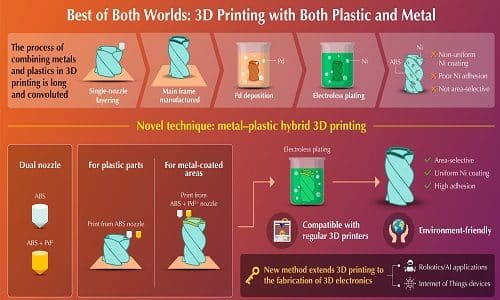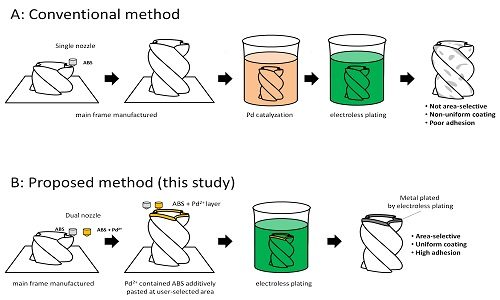The novel method to print 3D structures made of metal and plastic can be useful for 3D electronics applications

3D printing technology has evolved tremendously over the last decade to the point where it is now viable for mass production in industrial settings. Also known as “additive manufacturing,” 3D printing allows one to create arbitrarily complex 3D objects directly from their raw materials. The most popular 3D printing process is the fused filament fabrication in which a plastic or metal is melted and then ejected through a small nozzle by a printer head, which immediately solidifies and fuses with the rest of the piece. However, the melting points of plastics and metals are very different, limiting this technology to create objects of either metal or plastic only.
Now scientists from Waseda University, Japan, have discovered a new hybrid technique that can produce 3D objects made of both metal and plastic. The new method is a major improvement over conventional metallization process for coating 3D plastic structures with metal.
“Even though 3D printers let us create 3D structures from metal and plastic, most of the objects we see around us are a combination of both, including electronic devices. Thus, we thought we’d be able to expand the applications of conventional 3D printers if we managed to use them to create 3D objects made of both metal and plastic,” said Shinjiro Umezu, professor at Department of Modern Mechanical Engineering, Waseda University.
Hybrid Technique
Conventionally, the plastic object is 3D-printed and then submerged in a solution containing palladium (Pd), which adheres to the object’s surface. Afterwards, the piece is submerged in an electroless plating bath. With the help of the deposited Pd acting as a catalyst, the metal ions get dissolved to stick to the object. Although this process is technically sound, a non-uniform metallic coating gets produced, which adheres poorly to the plastic structure.
In contrast, the new hybrid technique employs a printer with a dual nozzle: one for extruding standard melted plastic (acrylonitrile butadiene styrene or ABS) and other for extruding ABS loaded with PdCl2. By selectively printing layers using one nozzle or the other, specific areas of the 3D object are loaded with Pd. Then, through electroless plating, one finally obtains a plastic structure with a metallic coating over selected areas only.

Aiming For Future Of 3D Printing
It was found that the adhesion of the metal coating was much higher using this approach. Also, since the Pd is loaded in the raw material, the technique does not require any type of roughening or etching of the ABS structure to promote the deposition of the catalyst (unlike in the conventional method). This is especially important as the extra steps (involved in the conventional method) cause damage not only to the 3D object itself but to the environment as well due to the use of chromic acid, a toxic chemical. Finally, the hybrid approach is entirely compatible with existing fused filament fabrication 3D printers.
The research paves the way for developing hybrid 3D printing technology, with the metal-plastic hybrid 3D printing becoming very relevant in 3D electronics use for Internet-of-Things and artificial intelligence applications. “Our hybrid 3D printing method has opened up the possibility of fabricating 3D electronics so that devices and robots used in healthcare and nursing care could become significantly better than what we have today,” said Shinjiro Umezu
And that will enable to get the best of both worlds — metal and plastic combined.
For more in-depth information, read here.








